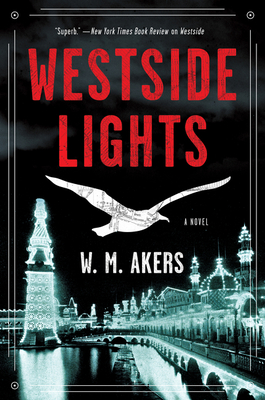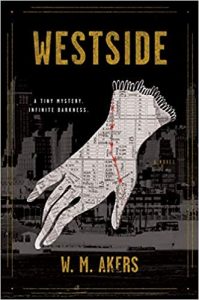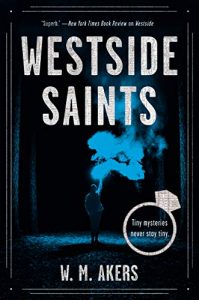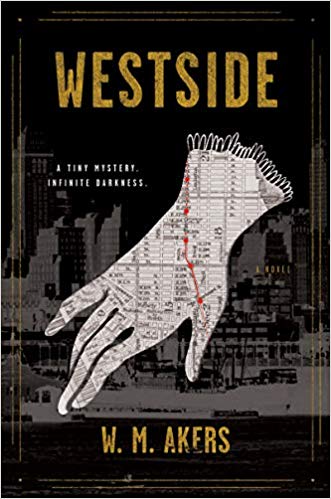 Westside Lights (Westside #3) by W.M. Akers
Westside Lights (Westside #3) by W.M. Akers Format: eARC
Source: supplied by publisher via Edelweiss
Formats available: hardcover, ebook, audiobook
Genres: alternate history, fantasy, historical fantasy, urban fantasy
Series: Westside #3
Pages: 288
Published by Harper Voyager on March 8, 2022
Purchasing Info: Author's Website, Publisher's Website, Amazon, Barnes & Noble, Kobo, Bookshop.org, Better World Books
Goodreads
The Alienist meets the magical mystery of The Ninth House as W. M. Akers returns with the third book in his critically acclaimed Jazz Age fantasy series set in the dangerous westside of New York City, following private detective Gilda Carr's hunt for the truth--one tiny mystery at a time.
The Westside of Manhattan is desolate, overgrown, and dangerous—and Gilda Carr wouldn’t have it any other way. An eccentric detective whose pursuit of tiny mysteries has dragged her to the brink of madness, Gilda spends 1923 searching for something that’s eluded her for years: peace. On the revitalized waterfront of the Lower West, Gilda and the gregarious ex-gangster Cherub Stevens start a new life on a stolen yacht. But their old life isn’t done with them yet.
They dock their boat on the edge of the White Lights District, a new tenderloin where liquor, drugs, sex, and violence are shaken into a deadly cocktail. When her pet seagull vanishes into the District, Gilda throws herself into the search for the missing bird. Up late watching the river for her pet, Gilda has one drink too many and passes out in the cabin of her waterfront home.
She wakes to a massacre.
Eight people have been slaughtered on the deck of the Misery Queen, and Cherub is among the dead. Gilda, naturally, is the prime suspect. Hunted by the police, the mob, and everyone in between, she must stay free long enough to find the person who stained the Hudson with her beloved’s blood. She will discover that on her Westside, no lights are bright enough to drive away the darkness.
My Review:
 Westside is a place caught between “never was” and “might have been”. It’s a kind of road not taken made manifest in a world where “something” happened at the turn of the 19th century into the 20th that cleaved the west side of New York City away from not just the rest of the city – or even the rest of the country – but from reality itself.
Westside is a place caught between “never was” and “might have been”. It’s a kind of road not taken made manifest in a world where “something” happened at the turn of the 19th century into the 20th that cleaved the west side of New York City away from not just the rest of the city – or even the rest of the country – but from reality itself.
Not completely. It is still possible to cross from one side to the other. But those crossings are regulated and controlled. There are fixed checkpoints between them. Because the shadowy darkness that looms over the Westside holds beasts and terrors that no one in the rest of the city wants to let slip through any cracks.
There are monsters on the Westside. Especially the two-legged kind that humans get reduced to when things get darkest – right before they turn completely black.
The first Westside story, simply titled Westside, was a surprise and a delight and a descent into darkness – all at the same time. The second book, Westside Saints – began with a real bang.
This third book, Westside Lights, begins with a whimper. It begins with Gilda Carr, solver of tiny mysteries, waking to the blood-soaked mess of a really big one. Leaving her to discover just who murdered all her friends and left her holding the quite literally bloody bag.
We start this story at seemingly the end. Gilda wakes up, everyone she’s been spending this strange, mysteriously light-saturated Westside summer with is dead all around her. As the only survivor of what looks like a massacre she is accused of the crime.
So she runs, intending to discover just who set her up to take this terrible fall – and turn it back on them before it’s too late for her.
But her search for the truth sees her examining the recent past, and the odd “miracle” that brought light back to the dark Westside – and tourists and pleasure seekers along with it.
Someone should have remembered that things that are too good to be true usually are, one bloody way or another. Especially in Westside.
 Escape Rating A: Everything about the Westside is weird and weirdly fascinating. Also just weird. Did I say weird? The whole idea that part of NYC could just separate itself into another reality is weird, fascinating and a whole bunch of other bizarre things.
Escape Rating A: Everything about the Westside is weird and weirdly fascinating. Also just weird. Did I say weird? The whole idea that part of NYC could just separate itself into another reality is weird, fascinating and a whole bunch of other bizarre things.
Even after three books we still don’t really know why it happened or how it happened, just that it did. And that the humans have self-sorted between the two sides – and even between the various criminal factions on the Westside itself since it happened.
But it’s every bit as complicated as it is fascinating. Which means that this series goes further down into the rabbit hole as it goes along. Meaning that Westside Lights is NOT the place to start. The place to start is Westside, where the reader gets introduced both to this place and to its denizens – especially Gilda Carr, that solver of tiny mysteries.
Tiny mysteries are the little things that make you wake up at 2 am – but aren’t so big that you won’t be able to get back to sleep. They’re niggling little questions that pop up at odd moments and just beg to be solved – even though the solution will have little to no effect on anything important.
Gilda solves tiny mysteries because she’s not crazy enough to pull at the threads of the big mysteries that lie under Westside. What makes these books so compelling is that no matter how much she tries to confine herself to the little things, she usually finds herself neck deep in the big things anyway.
Like Gilda’s previous “adventures” in this one she starts out investigating one thing – the death of the people she’s spent the summer with – and ends up looking into something entirely different. She starts out looking for a crazed, garden-variety murderer and ends up trying to figure out why the birds are dying.
But that’s part of Gilda’s charm, a charm that has carried her through three surprising adventures so far. I never expected this series to even BE a series, but I’m glad it is. And I’d love to follow Gilda as she solves as many “tiny” mysteries as she can find!

 Westside Saints by
Westside Saints by  Westside by
Westside by 